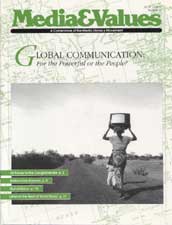Disaster Pornography from Somalia
|
This piece originally appeared in the Los Angeles Times. It is reprinted with permission of the authors. This article originally appeared in Issue# 61
|
In the vanguard of the Marines, the press corps had already stormed Somailia. Now we will see more of the famailiar pictures of grotesque human degradation, with foreign angels of mercy ministering to starving children, juxtaposed with images of trigger-happy teen-age looters. Such pictures prompted President Bush's military adventure-now they will justify it.
The camera can't lie, we are told. But anyone who has watched a Western film crew in an African famine will know just how much effort it takes to compose the "right" image. Photogenic starving children are hard to find, even in Somalia.
Somali doctors and nurses have expressed shock at the conduct of film crews in hospitals. They rush through crowded corridors, leaping over stretchers, dashing to film the agony before it passes. They hold bedside vigils to record the moment of death. When the Italian actress Sophia Loren visited Somalia, the paparazzi trampled on children as they scrambled to film her feeding a little girl-three times. This is disaster pornography.
Reduced to nameless extras in the shadows behind Western aid workers or disaster tourists, the grieving, hurting and humiliated human beings are not asked if they want to be portrayed in this degrading way.
Do pictures of Somalia show herdsmen tending large flocks of well-fed camels, or farmers cultivating ripening crops of sorghum and maize? Do they show vegetable markets flourishing in Mogadishu? Are we allowed to see clan elders negotiating a local cease fire, or the women who have turned their homes over to orphanages, filled with the laughter of healthy children? All these are just as much facets of life in Somalia today as looting and starvation, but they are not what we are shown.
The truth is that, even in the areas of the country stricken by famine, outright starvation is the exception. Most deaths are the result of disease. The great majority of people will survive-largely due to their own efforts. International food aid is much less important than food grown by local farmers, the maintenance of animal herds, having roots and berries to eat and charity of relatives and friends.
The most respectable excuse for selectively presenting images of starvation is that this is necessary to elicit our charity. But famine relief experts concur that the total impact of our charitable giving is less than what can be achieved if the stricken people are enabled to help themselves.
If "Operation Restore Hope" is to live up to its name, first it must restore humanity, self-respect and dignity to the Somali people. This cannot be done while the press corps makes disaster pornography pass for a true portrait of the Somali nation. No more, please.



